Risk Analysis and Project Management for Bucks Student Union Festival
VerifiedAdded on 2023/01/12
|14
|1947
|54
Report
AI Summary
This report provides a comprehensive analysis of project management methodologies, specifically in the context of the Bucks Student's Union Music Festival. It compares and contrasts various methodologies like the Waterfall model, hybrid approach, and critical path method, ultimately determining the critical path method as the most suitable for this event. The report includes a detailed network diagram with calculations for earliest start time, earliest finish time, latest start time, and latest finish time for each activity. Furthermore, it presents a stakeholder analysis, identifying key stakeholders and their levels of power and interest, along with a work breakdown structure for the festival. Finally, the report includes a risk analysis, identifying five potential risks that could affect the project and proposing mitigation strategies for each.
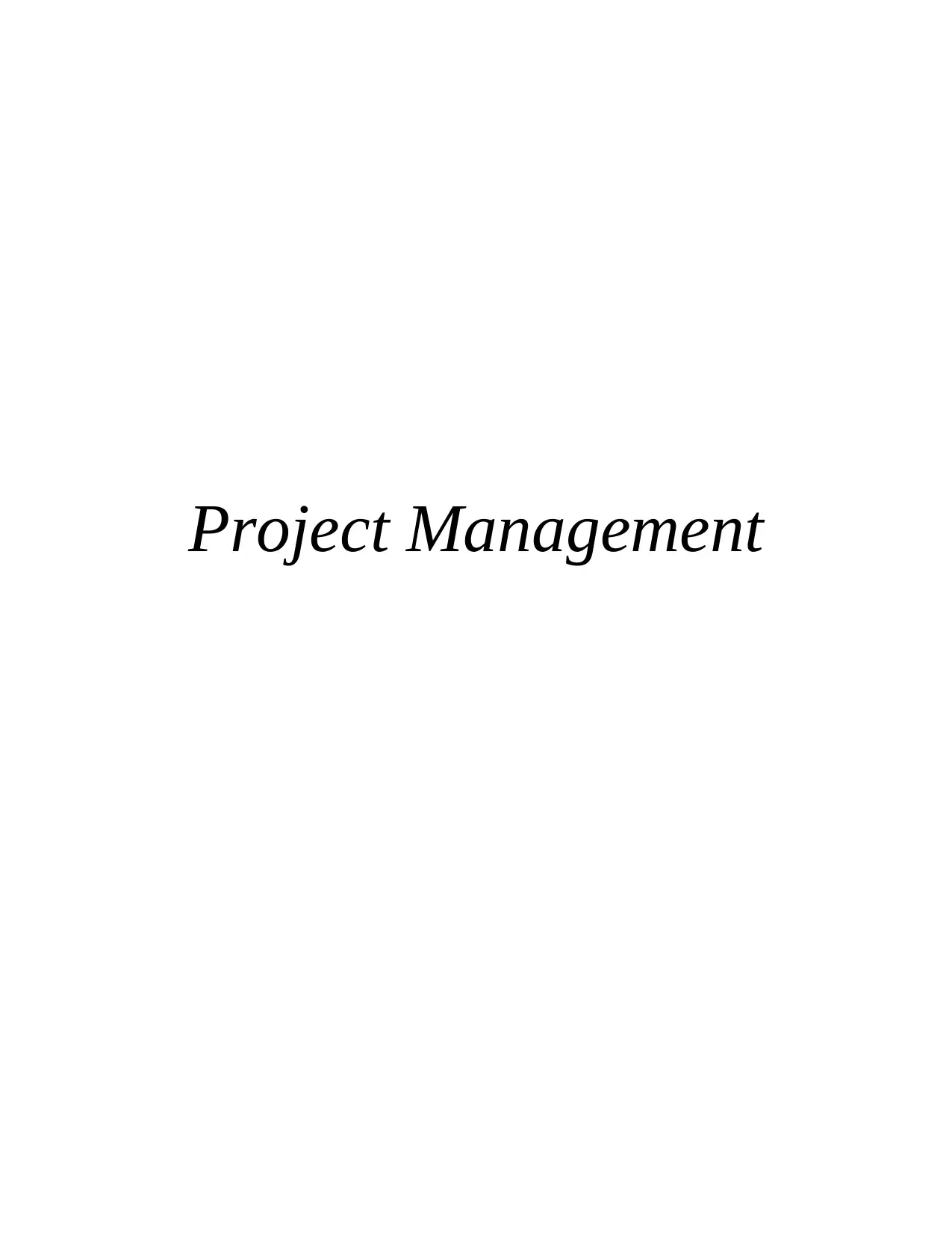
Project Management
Paraphrase This Document
Need a fresh take? Get an instant paraphrase of this document with our AI Paraphraser
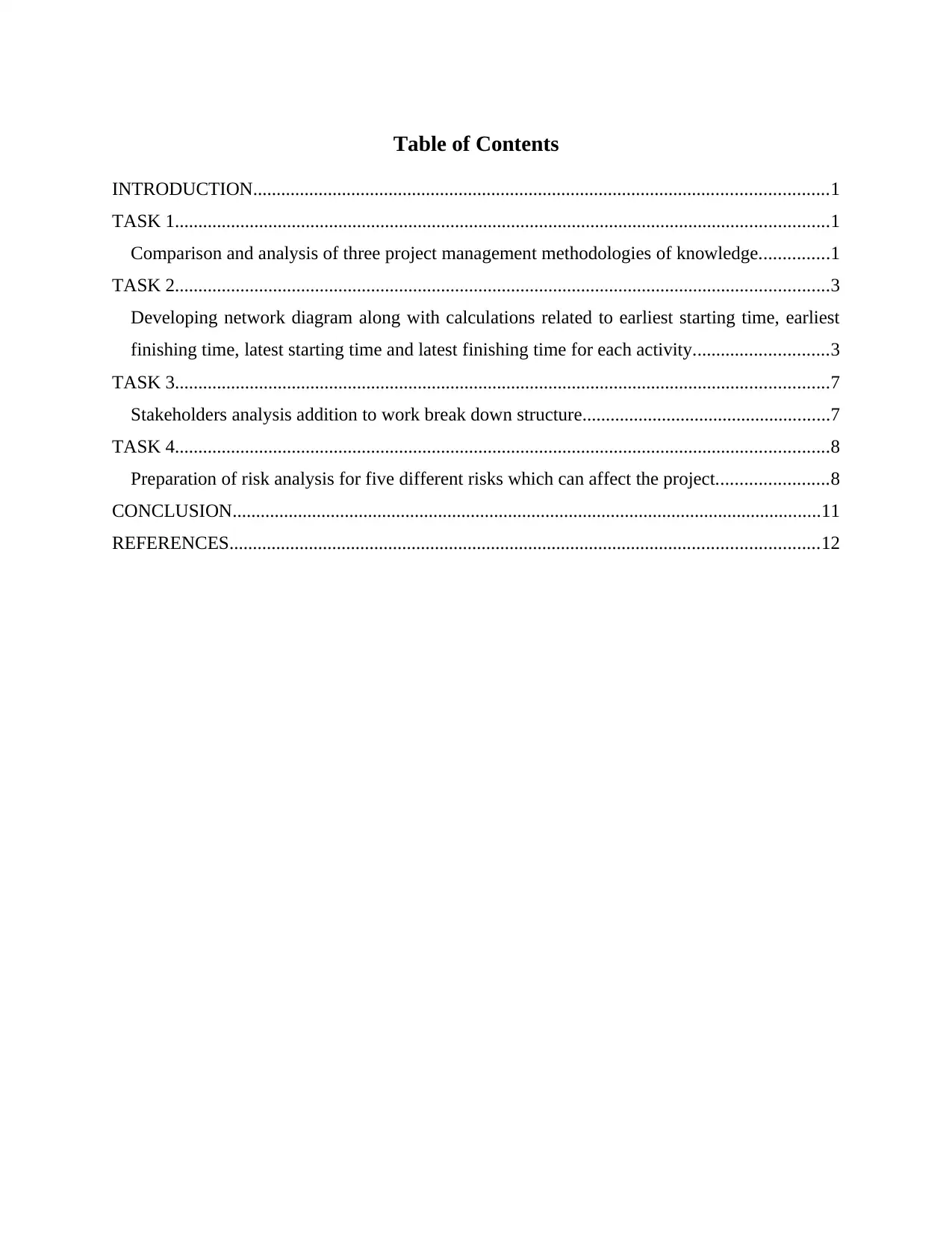
Table of Contents
INTRODUCTION...........................................................................................................................1
TASK 1............................................................................................................................................1
Comparison and analysis of three project management methodologies of knowledge...............1
TASK 2............................................................................................................................................3
Developing network diagram along with calculations related to earliest starting time, earliest
finishing time, latest starting time and latest finishing time for each activity.............................3
TASK 3............................................................................................................................................7
Stakeholders analysis addition to work break down structure.....................................................7
TASK 4............................................................................................................................................8
Preparation of risk analysis for five different risks which can affect the project........................8
CONCLUSION..............................................................................................................................11
REFERENCES..............................................................................................................................12
INTRODUCTION...........................................................................................................................1
TASK 1............................................................................................................................................1
Comparison and analysis of three project management methodologies of knowledge...............1
TASK 2............................................................................................................................................3
Developing network diagram along with calculations related to earliest starting time, earliest
finishing time, latest starting time and latest finishing time for each activity.............................3
TASK 3............................................................................................................................................7
Stakeholders analysis addition to work break down structure.....................................................7
TASK 4............................................................................................................................................8
Preparation of risk analysis for five different risks which can affect the project........................8
CONCLUSION..............................................................................................................................11
REFERENCES..............................................................................................................................12
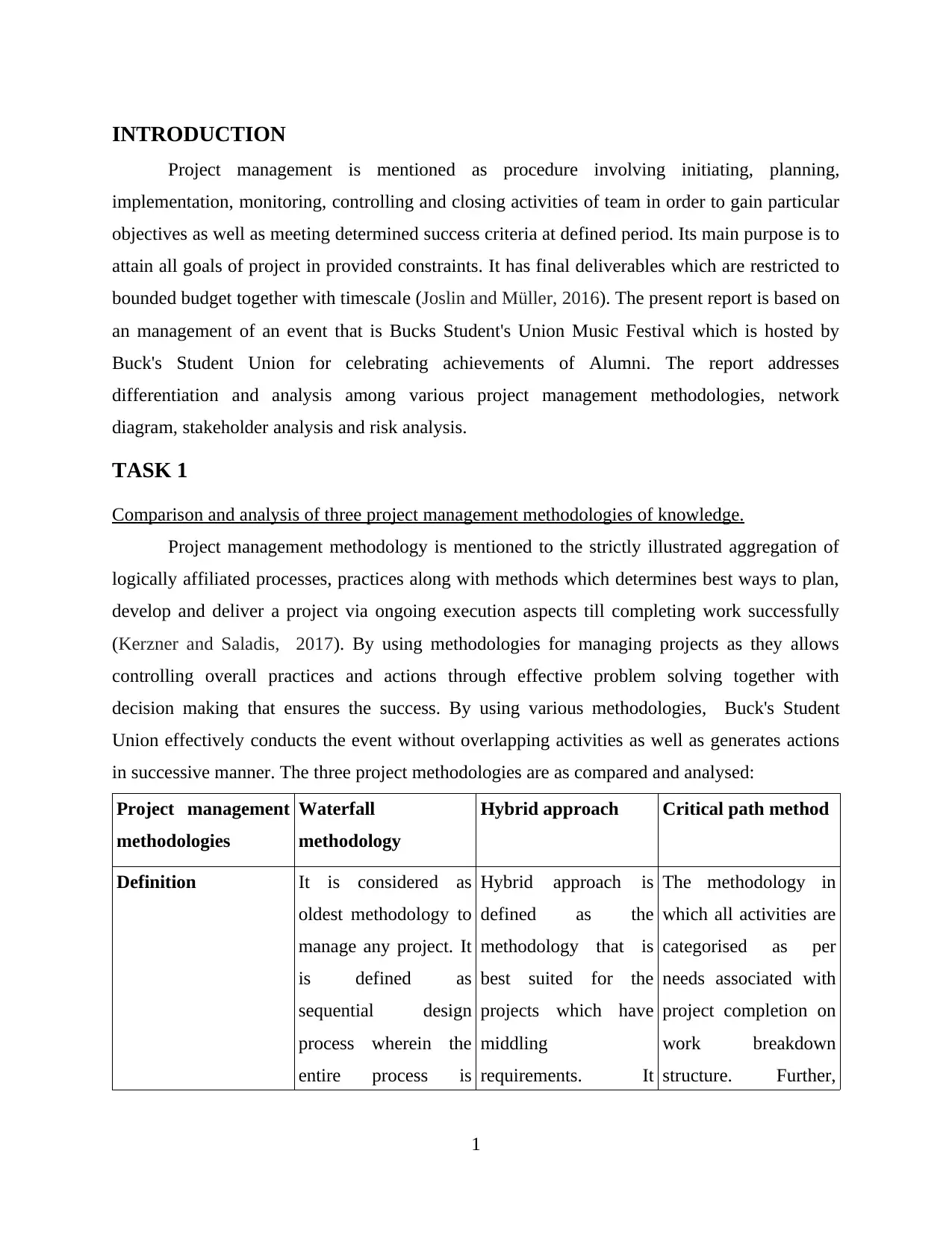
INTRODUCTION
Project management is mentioned as procedure involving initiating, planning,
implementation, monitoring, controlling and closing activities of team in order to gain particular
objectives as well as meeting determined success criteria at defined period. Its main purpose is to
attain all goals of project in provided constraints. It has final deliverables which are restricted to
bounded budget together with timescale (Joslin and Müller, 2016). The present report is based on
an management of an event that is Bucks Student's Union Music Festival which is hosted by
Buck's Student Union for celebrating achievements of Alumni. The report addresses
differentiation and analysis among various project management methodologies, network
diagram, stakeholder analysis and risk analysis.
TASK 1
Comparison and analysis of three project management methodologies of knowledge.
Project management methodology is mentioned to the strictly illustrated aggregation of
logically affiliated processes, practices along with methods which determines best ways to plan,
develop and deliver a project via ongoing execution aspects till completing work successfully
(Kerzner and Saladis, 2017). By using methodologies for managing projects as they allows
controlling overall practices and actions through effective problem solving together with
decision making that ensures the success. By using various methodologies, Buck's Student
Union effectively conducts the event without overlapping activities as well as generates actions
in successive manner. The three project methodologies are as compared and analysed:
Project management
methodologies
Waterfall
methodology
Hybrid approach Critical path method
Definition It is considered as
oldest methodology to
manage any project. It
is defined as
sequential design
process wherein the
entire process is
Hybrid approach is
defined as the
methodology that is
best suited for the
projects which have
middling
requirements. It
The methodology in
which all activities are
categorised as per
needs associated with
project completion on
work breakdown
structure. Further,
1
Project management is mentioned as procedure involving initiating, planning,
implementation, monitoring, controlling and closing activities of team in order to gain particular
objectives as well as meeting determined success criteria at defined period. Its main purpose is to
attain all goals of project in provided constraints. It has final deliverables which are restricted to
bounded budget together with timescale (Joslin and Müller, 2016). The present report is based on
an management of an event that is Bucks Student's Union Music Festival which is hosted by
Buck's Student Union for celebrating achievements of Alumni. The report addresses
differentiation and analysis among various project management methodologies, network
diagram, stakeholder analysis and risk analysis.
TASK 1
Comparison and analysis of three project management methodologies of knowledge.
Project management methodology is mentioned to the strictly illustrated aggregation of
logically affiliated processes, practices along with methods which determines best ways to plan,
develop and deliver a project via ongoing execution aspects till completing work successfully
(Kerzner and Saladis, 2017). By using methodologies for managing projects as they allows
controlling overall practices and actions through effective problem solving together with
decision making that ensures the success. By using various methodologies, Buck's Student
Union effectively conducts the event without overlapping activities as well as generates actions
in successive manner. The three project methodologies are as compared and analysed:
Project management
methodologies
Waterfall
methodology
Hybrid approach Critical path method
Definition It is considered as
oldest methodology to
manage any project. It
is defined as
sequential design
process wherein the
entire process is
Hybrid approach is
defined as the
methodology that is
best suited for the
projects which have
middling
requirements. It
The methodology in
which all activities are
categorised as per
needs associated with
project completion on
work breakdown
structure. Further,
1
⊘ This is a preview!⊘
Do you want full access?
Subscribe today to unlock all pages.

Trusted by 1+ million students worldwide
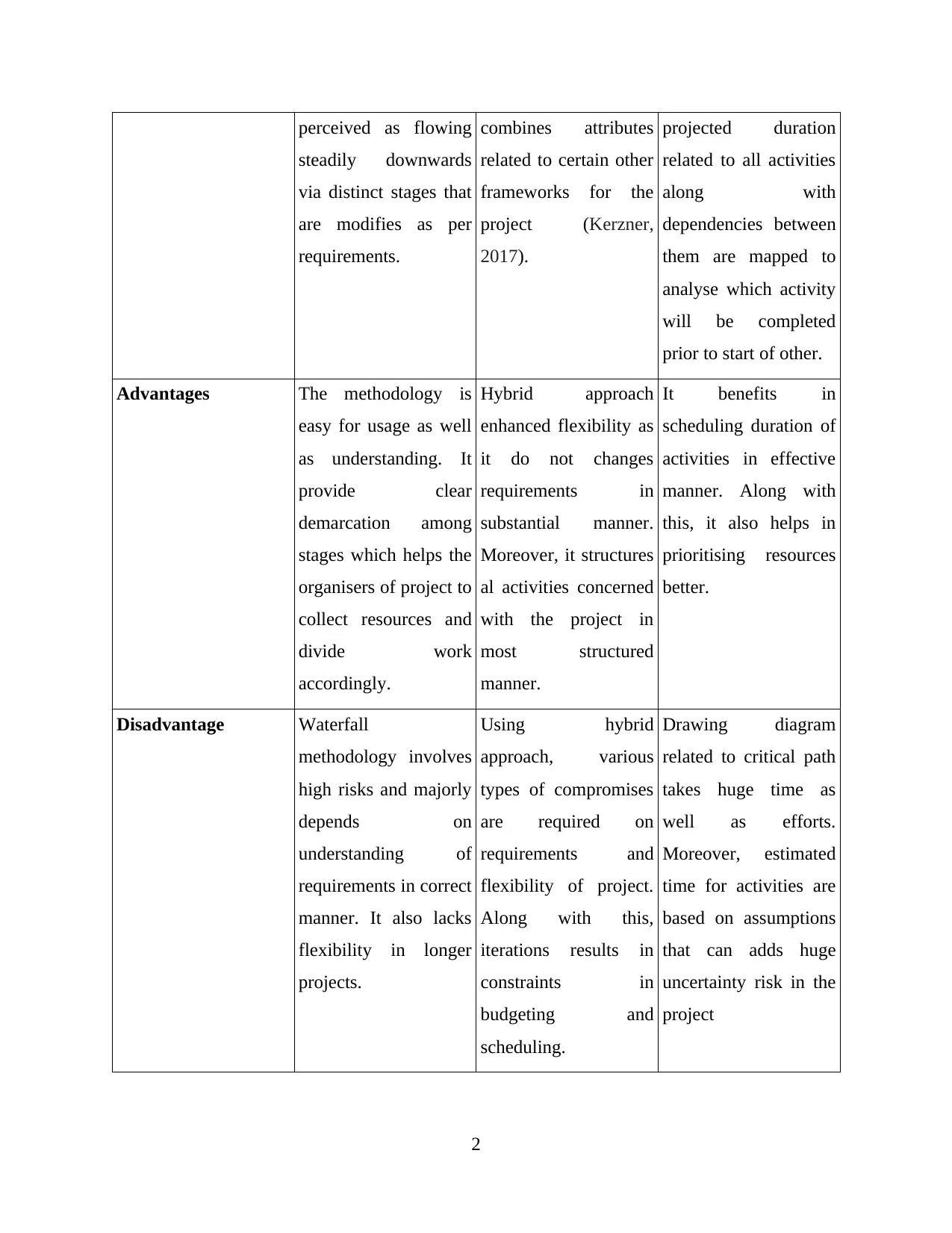
perceived as flowing
steadily downwards
via distinct stages that
are modifies as per
requirements.
combines attributes
related to certain other
frameworks for the
project (Kerzner,
2017).
projected duration
related to all activities
along with
dependencies between
them are mapped to
analyse which activity
will be completed
prior to start of other.
Advantages The methodology is
easy for usage as well
as understanding. It
provide clear
demarcation among
stages which helps the
organisers of project to
collect resources and
divide work
accordingly.
Hybrid approach
enhanced flexibility as
it do not changes
requirements in
substantial manner.
Moreover, it structures
al activities concerned
with the project in
most structured
manner.
It benefits in
scheduling duration of
activities in effective
manner. Along with
this, it also helps in
prioritising resources
better.
Disadvantage Waterfall
methodology involves
high risks and majorly
depends on
understanding of
requirements in correct
manner. It also lacks
flexibility in longer
projects.
Using hybrid
approach, various
types of compromises
are required on
requirements and
flexibility of project.
Along with this,
iterations results in
constraints in
budgeting and
scheduling.
Drawing diagram
related to critical path
takes huge time as
well as efforts.
Moreover, estimated
time for activities are
based on assumptions
that can adds huge
uncertainty risk in the
project
2
steadily downwards
via distinct stages that
are modifies as per
requirements.
combines attributes
related to certain other
frameworks for the
project (Kerzner,
2017).
projected duration
related to all activities
along with
dependencies between
them are mapped to
analyse which activity
will be completed
prior to start of other.
Advantages The methodology is
easy for usage as well
as understanding. It
provide clear
demarcation among
stages which helps the
organisers of project to
collect resources and
divide work
accordingly.
Hybrid approach
enhanced flexibility as
it do not changes
requirements in
substantial manner.
Moreover, it structures
al activities concerned
with the project in
most structured
manner.
It benefits in
scheduling duration of
activities in effective
manner. Along with
this, it also helps in
prioritising resources
better.
Disadvantage Waterfall
methodology involves
high risks and majorly
depends on
understanding of
requirements in correct
manner. It also lacks
flexibility in longer
projects.
Using hybrid
approach, various
types of compromises
are required on
requirements and
flexibility of project.
Along with this,
iterations results in
constraints in
budgeting and
scheduling.
Drawing diagram
related to critical path
takes huge time as
well as efforts.
Moreover, estimated
time for activities are
based on assumptions
that can adds huge
uncertainty risk in the
project
2
Paraphrase This Document
Need a fresh take? Get an instant paraphrase of this document with our AI Paraphraser
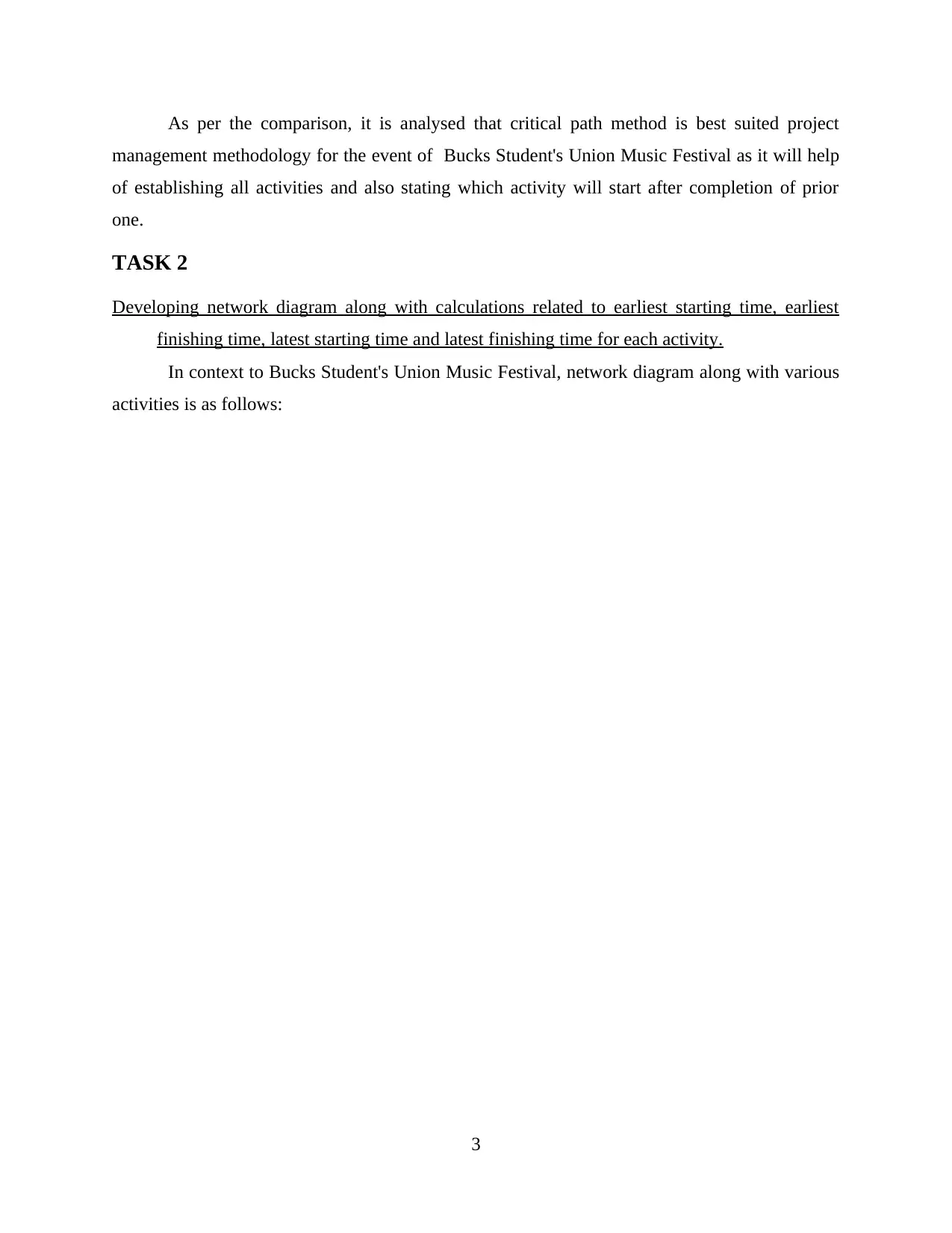
As per the comparison, it is analysed that critical path method is best suited project
management methodology for the event of Bucks Student's Union Music Festival as it will help
of establishing all activities and also stating which activity will start after completion of prior
one.
TASK 2
Developing network diagram along with calculations related to earliest starting time, earliest
finishing time, latest starting time and latest finishing time for each activity.
In context to Bucks Student's Union Music Festival, network diagram along with various
activities is as follows:
3
management methodology for the event of Bucks Student's Union Music Festival as it will help
of establishing all activities and also stating which activity will start after completion of prior
one.
TASK 2
Developing network diagram along with calculations related to earliest starting time, earliest
finishing time, latest starting time and latest finishing time for each activity.
In context to Bucks Student's Union Music Festival, network diagram along with various
activities is as follows:
3
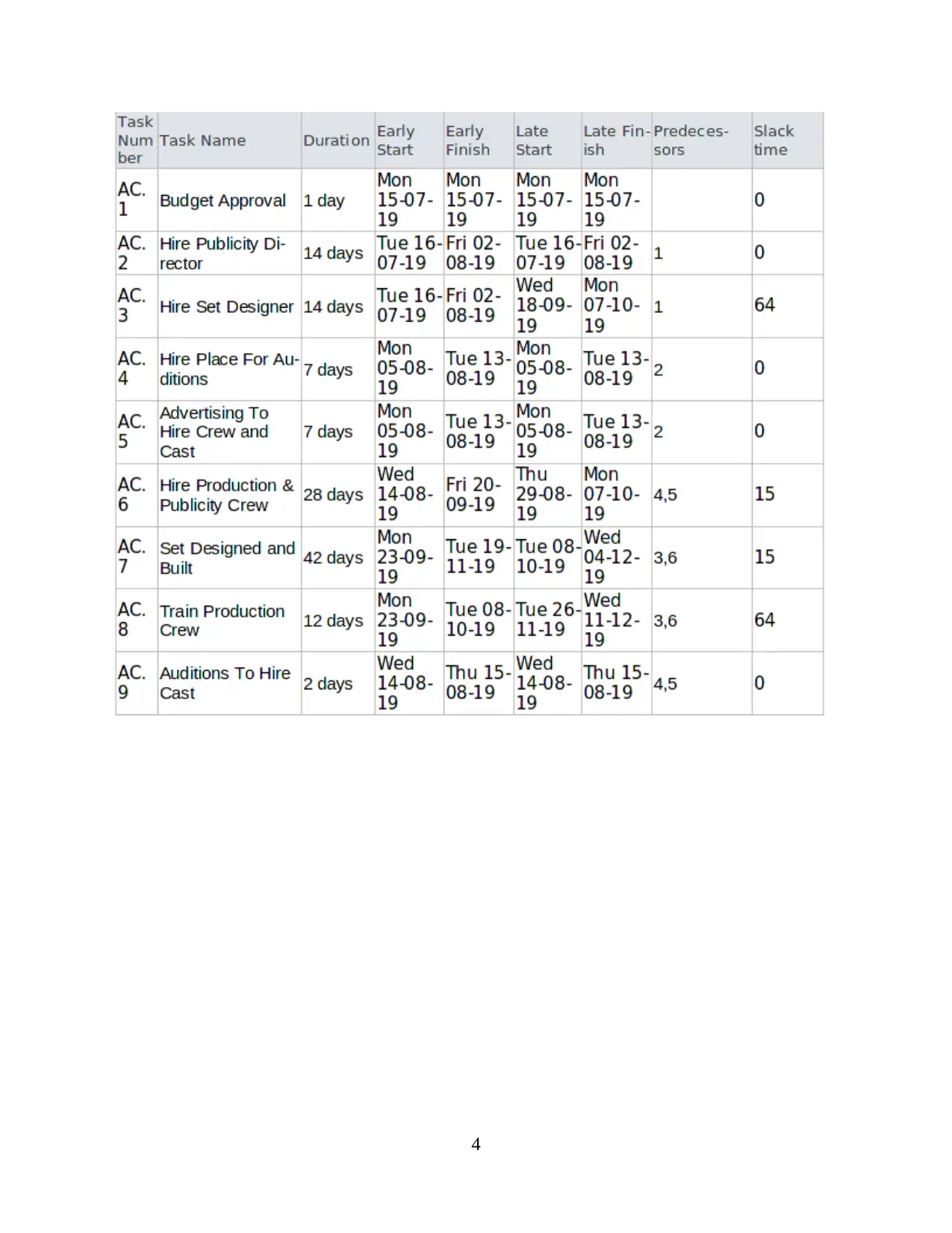
4
⊘ This is a preview!⊘
Do you want full access?
Subscribe today to unlock all pages.

Trusted by 1+ million students worldwide
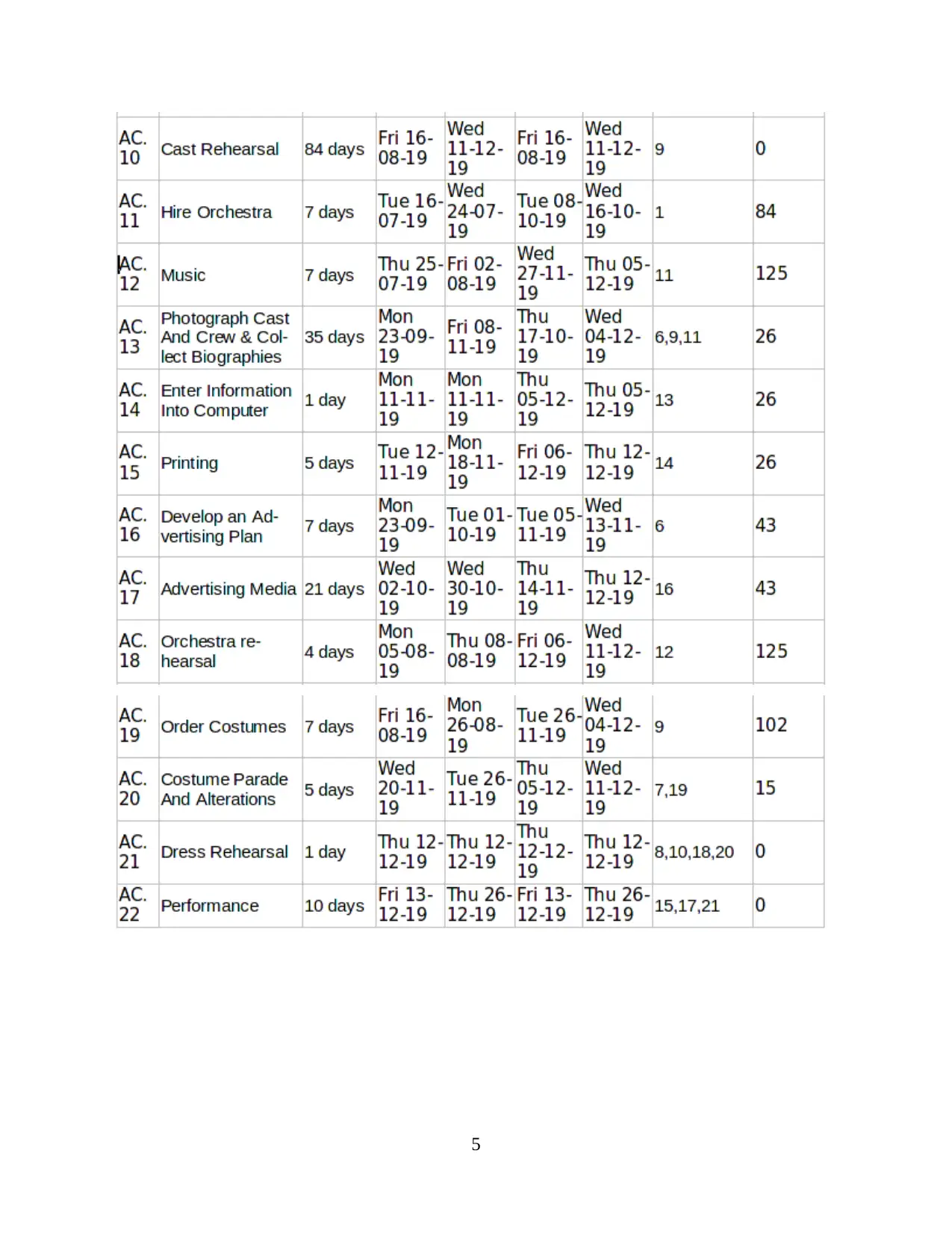
5
Paraphrase This Document
Need a fresh take? Get an instant paraphrase of this document with our AI Paraphraser
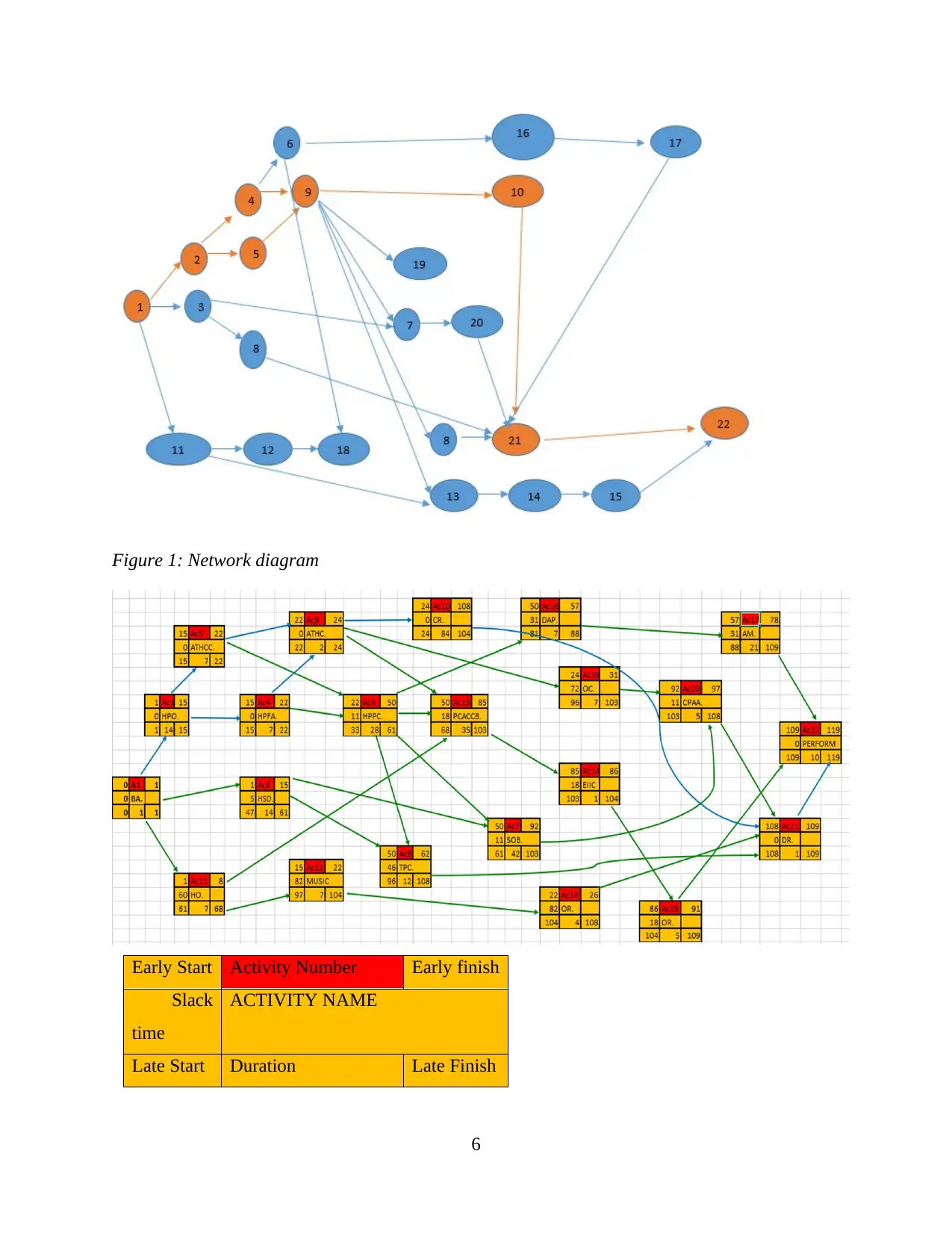
Figure 1: Network diagram
Early Start Activity Number Early finish
Slack
time
ACTIVITY NAME
Late Start Duration Late Finish
6
Early Start Activity Number Early finish
Slack
time
ACTIVITY NAME
Late Start Duration Late Finish
6
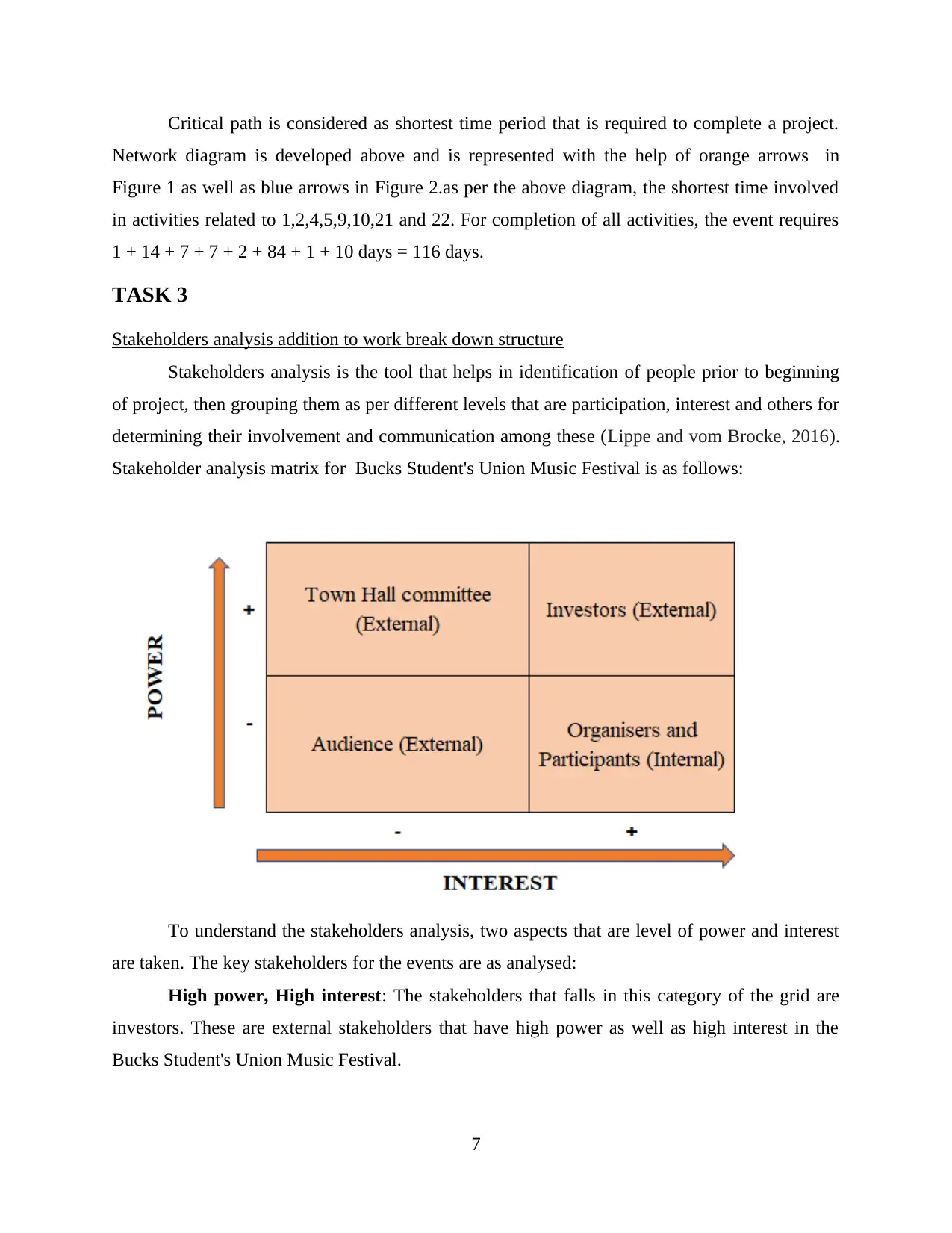
Critical path is considered as shortest time period that is required to complete a project.
Network diagram is developed above and is represented with the help of orange arrows in
Figure 1 as well as blue arrows in Figure 2.as per the above diagram, the shortest time involved
in activities related to 1,2,4,5,9,10,21 and 22. For completion of all activities, the event requires
1 + 14 + 7 + 7 + 2 + 84 + 1 + 10 days = 116 days.
TASK 3
Stakeholders analysis addition to work break down structure
Stakeholders analysis is the tool that helps in identification of people prior to beginning
of project, then grouping them as per different levels that are participation, interest and others for
determining their involvement and communication among these (Lippe and vom Brocke, 2016).
Stakeholder analysis matrix for Bucks Student's Union Music Festival is as follows:
To understand the stakeholders analysis, two aspects that are level of power and interest
are taken. The key stakeholders for the events are as analysed:
High power, High interest: The stakeholders that falls in this category of the grid are
investors. These are external stakeholders that have high power as well as high interest in the
Bucks Student's Union Music Festival.
7
Network diagram is developed above and is represented with the help of orange arrows in
Figure 1 as well as blue arrows in Figure 2.as per the above diagram, the shortest time involved
in activities related to 1,2,4,5,9,10,21 and 22. For completion of all activities, the event requires
1 + 14 + 7 + 7 + 2 + 84 + 1 + 10 days = 116 days.
TASK 3
Stakeholders analysis addition to work break down structure
Stakeholders analysis is the tool that helps in identification of people prior to beginning
of project, then grouping them as per different levels that are participation, interest and others for
determining their involvement and communication among these (Lippe and vom Brocke, 2016).
Stakeholder analysis matrix for Bucks Student's Union Music Festival is as follows:
To understand the stakeholders analysis, two aspects that are level of power and interest
are taken. The key stakeholders for the events are as analysed:
High power, High interest: The stakeholders that falls in this category of the grid are
investors. These are external stakeholders that have high power as well as high interest in the
Bucks Student's Union Music Festival.
7
⊘ This is a preview!⊘
Do you want full access?
Subscribe today to unlock all pages.

Trusted by 1+ million students worldwide
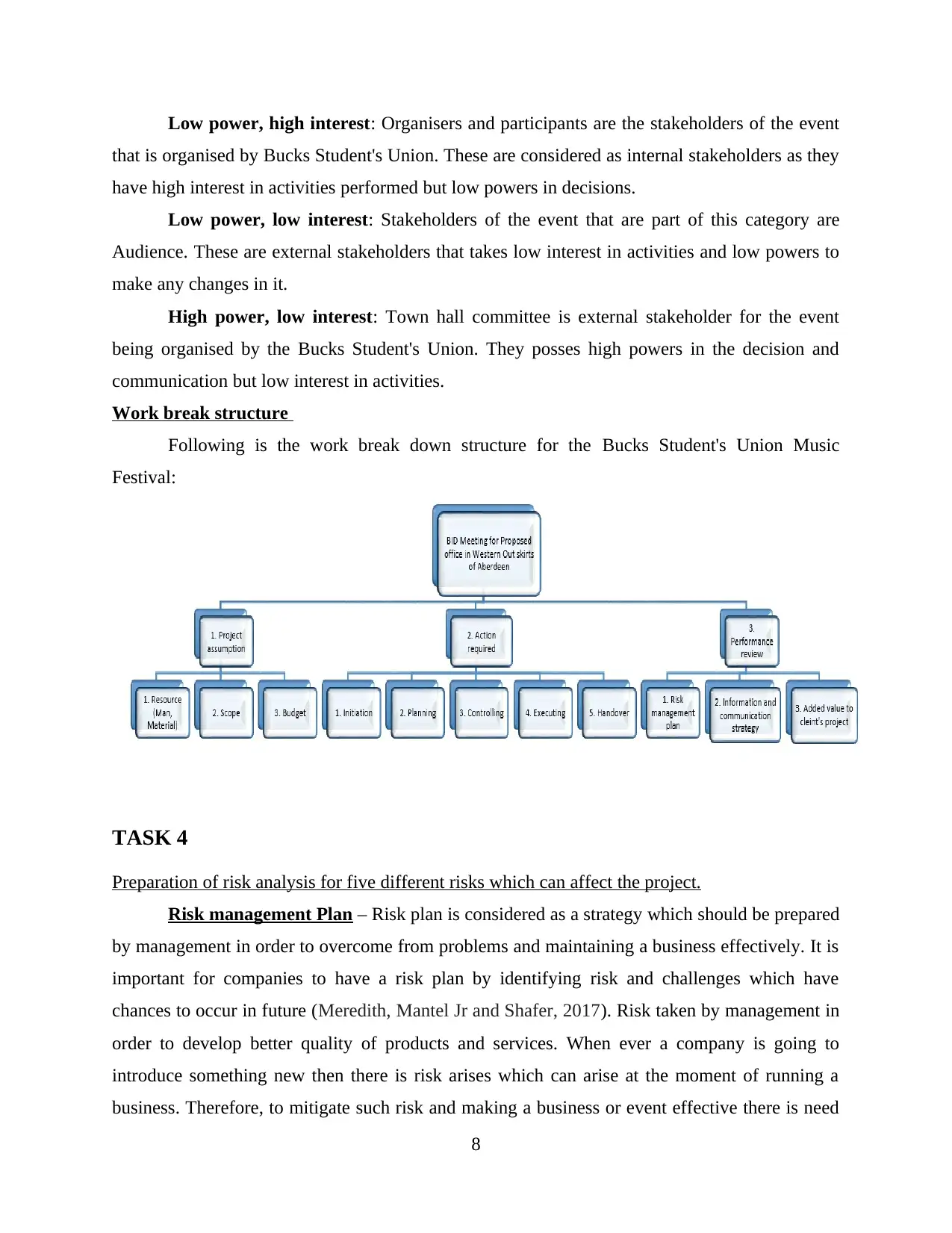
Low power, high interest: Organisers and participants are the stakeholders of the event
that is organised by Bucks Student's Union. These are considered as internal stakeholders as they
have high interest in activities performed but low powers in decisions.
Low power, low interest: Stakeholders of the event that are part of this category are
Audience. These are external stakeholders that takes low interest in activities and low powers to
make any changes in it.
High power, low interest: Town hall committee is external stakeholder for the event
being organised by the Bucks Student's Union. They posses high powers in the decision and
communication but low interest in activities.
Work break structure
Following is the work break down structure for the Bucks Student's Union Music
Festival:
TASK 4
Preparation of risk analysis for five different risks which can affect the project.
Risk management Plan – Risk plan is considered as a strategy which should be prepared
by management in order to overcome from problems and maintaining a business effectively. It is
important for companies to have a risk plan by identifying risk and challenges which have
chances to occur in future (Meredith, Mantel Jr and Shafer, 2017). Risk taken by management in
order to develop better quality of products and services. When ever a company is going to
introduce something new then there is risk arises which can arise at the moment of running a
business. Therefore, to mitigate such risk and making a business or event effective there is need
8
that is organised by Bucks Student's Union. These are considered as internal stakeholders as they
have high interest in activities performed but low powers in decisions.
Low power, low interest: Stakeholders of the event that are part of this category are
Audience. These are external stakeholders that takes low interest in activities and low powers to
make any changes in it.
High power, low interest: Town hall committee is external stakeholder for the event
being organised by the Bucks Student's Union. They posses high powers in the decision and
communication but low interest in activities.
Work break structure
Following is the work break down structure for the Bucks Student's Union Music
Festival:
TASK 4
Preparation of risk analysis for five different risks which can affect the project.
Risk management Plan – Risk plan is considered as a strategy which should be prepared
by management in order to overcome from problems and maintaining a business effectively. It is
important for companies to have a risk plan by identifying risk and challenges which have
chances to occur in future (Meredith, Mantel Jr and Shafer, 2017). Risk taken by management in
order to develop better quality of products and services. When ever a company is going to
introduce something new then there is risk arises which can arise at the moment of running a
business. Therefore, to mitigate such risk and making a business or event effective there is need
8
Paraphrase This Document
Need a fresh take? Get an instant paraphrase of this document with our AI Paraphraser
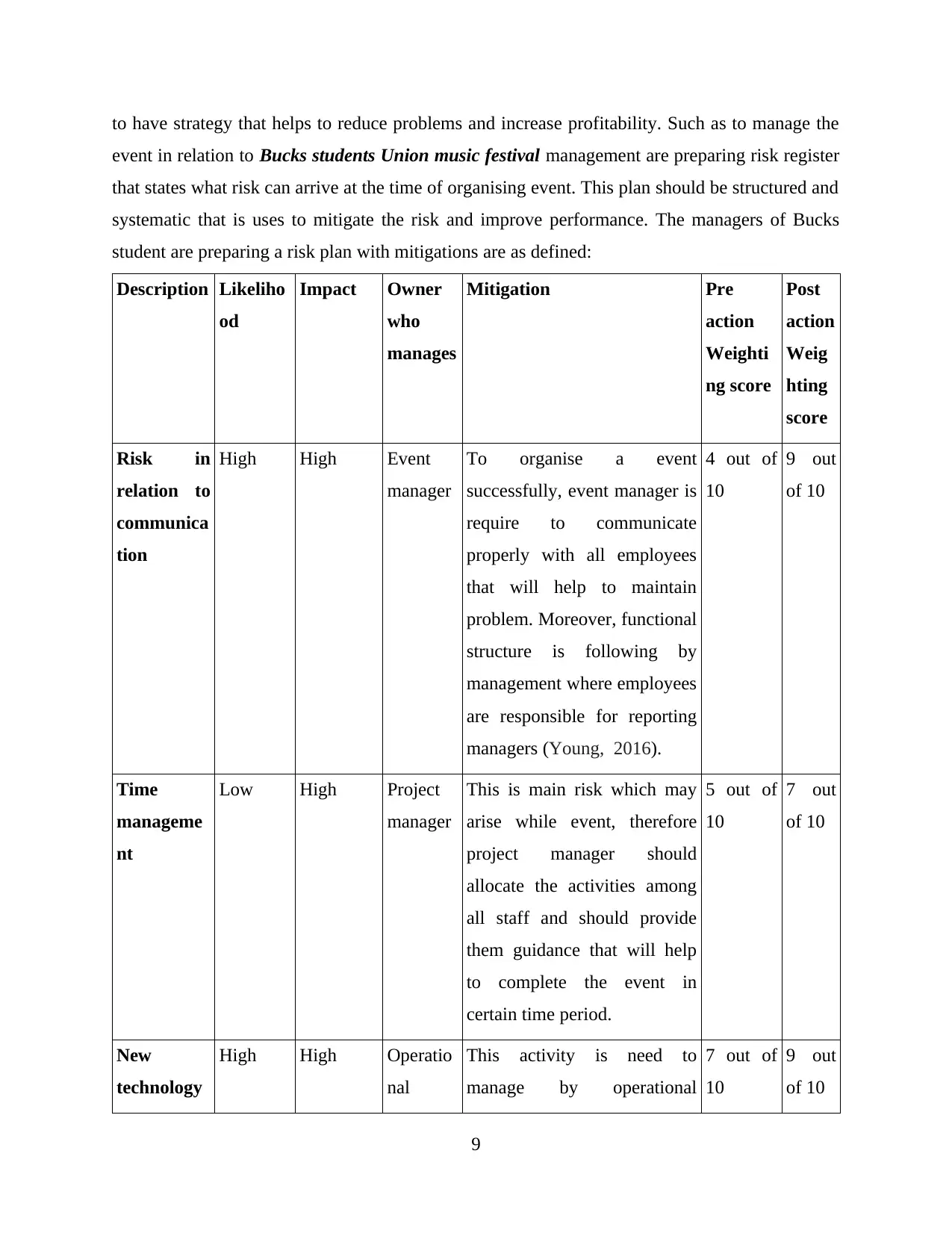
to have strategy that helps to reduce problems and increase profitability. Such as to manage the
event in relation to Bucks students Union music festival management are preparing risk register
that states what risk can arrive at the time of organising event. This plan should be structured and
systematic that is uses to mitigate the risk and improve performance. The managers of Bucks
student are preparing a risk plan with mitigations are as defined:
Description Likeliho
od
Impact Owner
who
manages
Mitigation Pre
action
Weighti
ng score
Post
action
Weig
hting
score
Risk in
relation to
communica
tion
High High Event
manager
To organise a event
successfully, event manager is
require to communicate
properly with all employees
that will help to maintain
problem. Moreover, functional
structure is following by
management where employees
are responsible for reporting
managers (Young, 2016).
4 out of
10
9 out
of 10
Time
manageme
nt
Low High Project
manager
This is main risk which may
arise while event, therefore
project manager should
allocate the activities among
all staff and should provide
them guidance that will help
to complete the event in
certain time period.
5 out of
10
7 out
of 10
New
technology
High High Operatio
nal
This activity is need to
manage by operational
7 out of
10
9 out
of 10
9
event in relation to Bucks students Union music festival management are preparing risk register
that states what risk can arrive at the time of organising event. This plan should be structured and
systematic that is uses to mitigate the risk and improve performance. The managers of Bucks
student are preparing a risk plan with mitigations are as defined:
Description Likeliho
od
Impact Owner
who
manages
Mitigation Pre
action
Weighti
ng score
Post
action
Weig
hting
score
Risk in
relation to
communica
tion
High High Event
manager
To organise a event
successfully, event manager is
require to communicate
properly with all employees
that will help to maintain
problem. Moreover, functional
structure is following by
management where employees
are responsible for reporting
managers (Young, 2016).
4 out of
10
9 out
of 10
Time
manageme
nt
Low High Project
manager
This is main risk which may
arise while event, therefore
project manager should
allocate the activities among
all staff and should provide
them guidance that will help
to complete the event in
certain time period.
5 out of
10
7 out
of 10
New
technology
High High Operatio
nal
This activity is need to
manage by operational
7 out of
10
9 out
of 10
9
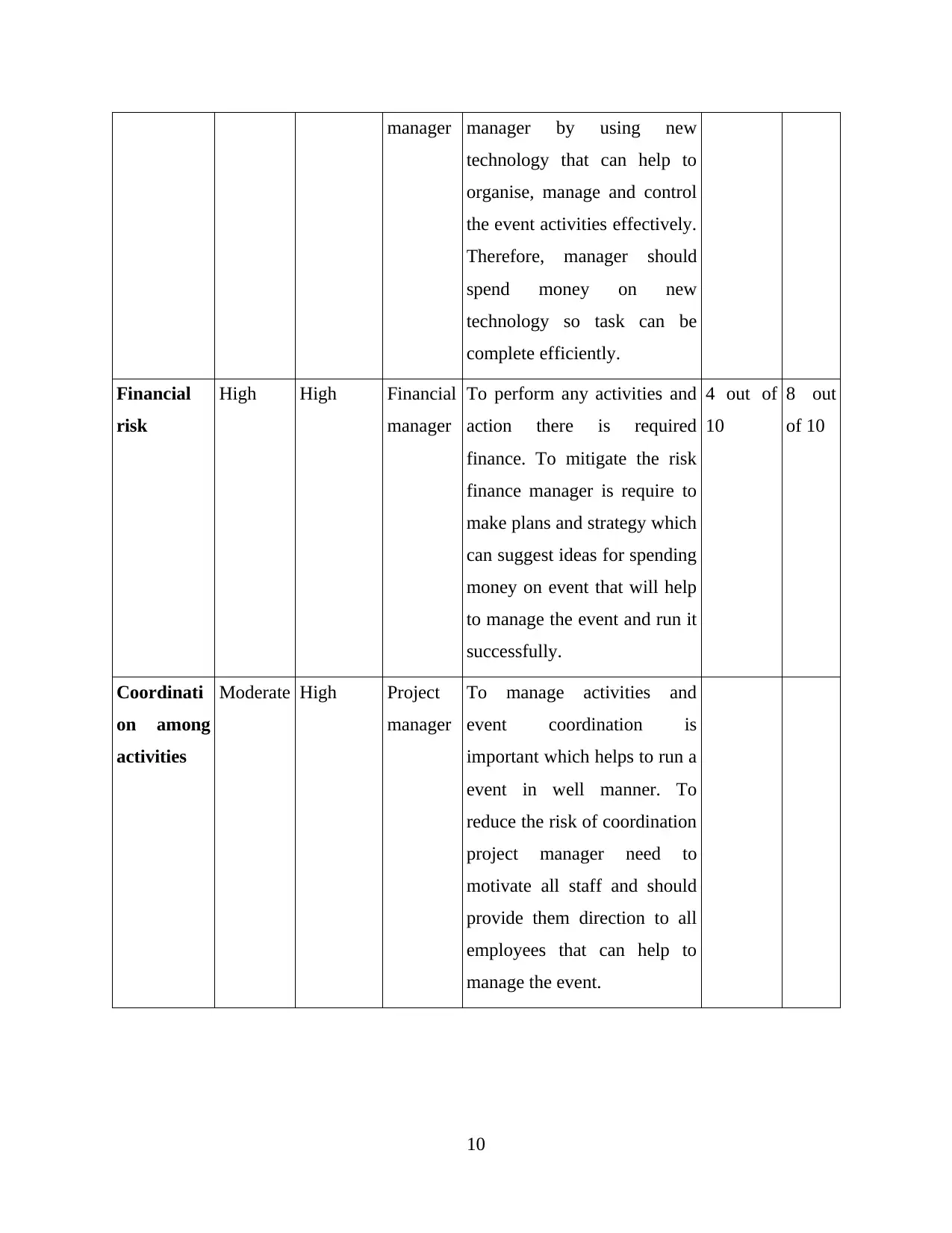
manager manager by using new
technology that can help to
organise, manage and control
the event activities effectively.
Therefore, manager should
spend money on new
technology so task can be
complete efficiently.
Financial
risk
High High Financial
manager
To perform any activities and
action there is required
finance. To mitigate the risk
finance manager is require to
make plans and strategy which
can suggest ideas for spending
money on event that will help
to manage the event and run it
successfully.
4 out of
10
8 out
of 10
Coordinati
on among
activities
Moderate High Project
manager
To manage activities and
event coordination is
important which helps to run a
event in well manner. To
reduce the risk of coordination
project manager need to
motivate all staff and should
provide them direction to all
employees that can help to
manage the event.
10
technology that can help to
organise, manage and control
the event activities effectively.
Therefore, manager should
spend money on new
technology so task can be
complete efficiently.
Financial
risk
High High Financial
manager
To perform any activities and
action there is required
finance. To mitigate the risk
finance manager is require to
make plans and strategy which
can suggest ideas for spending
money on event that will help
to manage the event and run it
successfully.
4 out of
10
8 out
of 10
Coordinati
on among
activities
Moderate High Project
manager
To manage activities and
event coordination is
important which helps to run a
event in well manner. To
reduce the risk of coordination
project manager need to
motivate all staff and should
provide them direction to all
employees that can help to
manage the event.
10
⊘ This is a preview!⊘
Do you want full access?
Subscribe today to unlock all pages.

Trusted by 1+ million students worldwide
1 out of 14
Related Documents
Your All-in-One AI-Powered Toolkit for Academic Success.
+13062052269
info@desklib.com
Available 24*7 on WhatsApp / Email
![[object Object]](/_next/static/media/star-bottom.7253800d.svg)
Unlock your academic potential
Copyright © 2020–2025 A2Z Services. All Rights Reserved. Developed and managed by ZUCOL.





